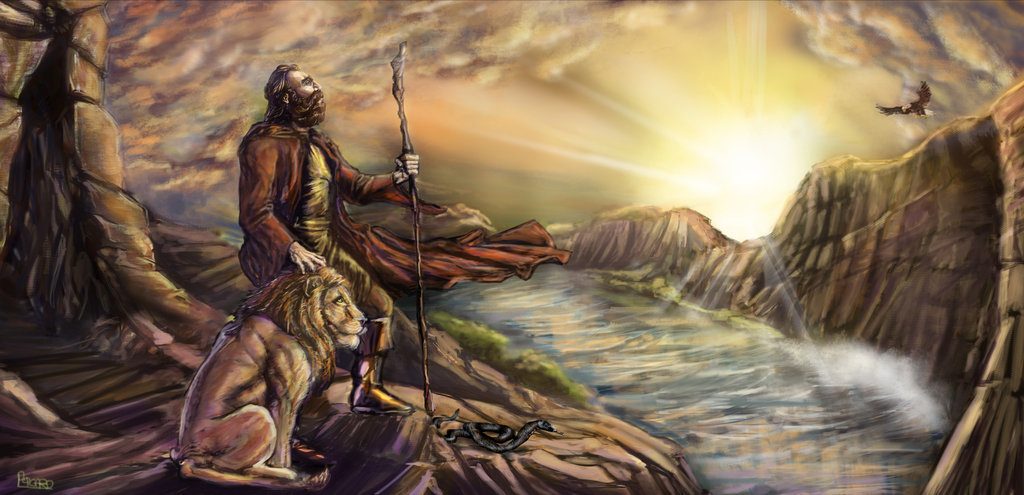Zoroastrianism was a dualist faith that originated in Persia, and over the years it has influenced a number of other faiths. Even though we may not recognize it today, it has been an influence on a number of world religions, especially on Christianity and Islam. Zoroastrianism is a belief system that stresses how we as human beings were meant to strive for our full potential. A primary tenet of the faith is that righteous and upstanding people will participate in the rewards of paradise, while the evil-doers will undergo punishments in hell.1
The prophet and founder of Zoroastrianism was Zarathustra, a man from an aristocratic family in Rhages, Media. Most scholars believe that Zarathustra was born around the late seventh and early sixth centuries B.C.E. He was a priest who became disillusioned with Persian ancestral religion, so instead he decided to search for inspiration and wisdom, and for a deeper meaning to life. After ten years of traveling, he finally realized that he had been called to be a prophet of Ahura Mazda, the Lord of Light. “He received a revelation in the form of the Avesta, the holy book of his religion, and commissioned to preach to humankind.”2 He would preach the Gathas; these were known as the hymns to the gods.
The central claim of Zoroastrianism is that there are two coequal and co-eternal gods: Ahura Mazda, the All-knowing Lord of Light, and Angra Mainyu or Ahriman, the Lord of Darkness. These gods represent an extreme dualism, where followers were given the option of choosing whom to worship. Ahura Mazda would save or condemn individuals based on whichever choice they decided to make.3 The people would experience rewards and punishments based on how they chose to behave. If they followed “Good words, Good thoughts, Good deeds,” they would be able to appreciate all the pleasures Ahura Mazda had in store for them in the afterlife.4

Devotees of Zoroastrianism believed that Ahura Mazda first produced the World of Thought and then gave birth to the World of the Living; but there was not yet life. Angra Mainyu challenged this pre-creation with his own counter-creation in order to destroy what Ahura Mazda was establishing. The Lord of Darkness wanted to demolish it with darkness, sickness, and death. Before Angra Mainyu was able to attack, Ahura Mazda forced him to recoil to the darkness. He was stunned into unconsciousness for three thousand years.5
Ahura Mazda then prepared for the Mixture of war, or battles against evil. This war was going to last six thousand years. For the first three thousand years, Ahura Mazda would unite with other lesser gods so that they could form a broad alliance. Angra Mainyu’s evil queen helped awaken the evil-doer and stirred all evil beings to attack Ahura Mazda. The battle then began, and Ahura Mazda’s creation came to life. Unfortunately, the very first beings killed were good, Gayomard and the Lone Bull; but from their semen they were able to manifest all humankind and bring into being all animals. Ahura Mazda’s right-hand man was Karsasp, a beautiful and innocent man, who helped fight off Angra Mainyu and his servants. Ahura Mazda then put Karsasp into a deep sleep so he would be well-rested for the very Last Battle.6 “At death, according to the tenets of Zoroastrianism, the souls of all persons ascend to the summit of Mount Hara where the good and bad of each soul are weighed in balances.”7 If one has made exceptional choices, ones soul will cross the cosmic bridge and continue an existence in heaven. In the case that many of one’s decisions were unacceptable, the bridge will disrupt and one’s soul will perish in hell. Scholar Charles David Isbell summarizes the eschatology of Zoroastrianism this way: “Since evil will have become extinct, history will come to an end, good souls will receive immortal bodies and will live forever in the re-perfected earth ruled over by Ahura-mazda.”8
This religion has continued to be practiced for as much as three thousand years. There are still a few thousand devotees that continue to carry on the traditions of Zoroastrianism in Iran and in India today. This religion has faced many difficulties in its long history, especially during the seventh century C.E. when invading Arab Muslims conquered the land of Persia, the homeland of Zoroastrianism. The conquerors chose not to take away this religion altogether, but they did choose to put a financial burden on the Zoroastrian temples.9 Many fled to India, which is home today to many of their descendants, known as Parsis. Many of those who stayed in Persia ended up converting to Islam. Although it may not be practiced as widely today, it has made a considerable impact on other religions.
Christianity was one of those religions that may have been influenced by elements within Zoroastrianism. Scholar John R. Hinnells writes,
It is generally held that the form of the later Jewish and Christian concept of the devil or Satan was influenced by Iranian tradition. If this be accepted then it has serious implications for the understanding of the saviour or Messianic figure…. When [the devil] becomes truly demonic … then the savior is given a new task.10
That task, Hinnells believes, was to defeat a supernatural and evil being, which taps into Zoroastrian dualism. In fact, the beliefs in a Satan of evil pitted against a God of good, the belief in angels and demons fighting a cosmic war, and the belief in a savior figure who would save all of humanity from evil and sin are all elements deriving from Zoroastrianism.11 Zoroastrianism in its original form may be an obscure faith in today’s society, but its impact on the fundamental principles of many religions is evident and deserves our appreciation and acknowledgement.
- Jerry Bentley, Herbert Ziegler, Heather Streets Salter, Traditions & Encounters: A Brief Global History Volume 1 (New York, NY: McGraw-Hill Publishers, 2016), 95-99. ↵
- Salem Press Biographical Encyclopedia, 2015, s.v. “Zoroaster,” by J. Steward Alverson. ↵
- Funk & Wagnalls New World Encyclopedia, 2016, s.v. “Ahura Mazda.” ↵
- Bentley, Ziegler, and Street Salter, Traditions & Encounters, 96-97. ↵
- P. Oktor Skjærvø, “Good vs. Evil,” Calliope 15, no. 5 (January 2005): 8. ↵
- P. Oktor Skjærvø, “Good vs. Evil,” Calliope 15, no. 5 (January 2005): 8. ↵
- Charles David Isbell, “Zoroastrianism and Biblical Religion,” Jewish Bible Quarterly (2006). ↵
- Charles David Isbell, “Zoroastrianism and Biblical Religion,” Jewish Bible Quarterly (2006). ↵
- Bentley, Ziegler, and Street Salter, Traditions & Encounters, 97-98. ↵
- John R. Hinnells, Zoroastrian and Parsi Studies: Selected Works of Johr R. Hinnells (Burlington, VT: Ashgate Publishing Co., 2000), 46. ↵
- Bryan Rennie, “Zoroastrianism: The Iranian Roots of Christianity,” The Council of Societies for the Study of Religion vol. 36 no. 1 (2007): 3-5. ↵



89 comments
Alexander Manibusan
I find it mind-boggling that Zoroastrianism influenced the two biggest current religions in the world. The fact that it is older than Judaism is also something mind-blowing. I would like to know exactly what the beliefs of the ancient Persians were. What did they believe in before the establishment of Zoroastrianism? It just makes the questions of religion even deeper. I wish I knew what it was like when Zarathustra became enlightened and found such profound wisdom.
Natalia Flores
I found the article very informative and well put together. It’s interesting to hear how the idea of dualism influenced many different religions including Islam and Christianity. Ahura Mazda and Angra Mainyu, both being all knowing and all present, sounds very similar to the notion of God and Satan. The battle between good and evil while at the same time being equals also sounds like yin and yang.
Jonathan Perez
The article was well researched and developed. I learned more about Zoroastrianism and how it came to be. I was also pleased to learn the details of its progression through time and how it has shaped religious groups today. Overall the article was well explained and offered insight on a topic that, unless one was looking for it, people would not know much about.
Samuel Ruiz
I remember learning about Zoroastrianism in class a few weeks ago. I loved the connections this article made of this religion to other religions. I found the prophet, Zarathustra, of Ahura Mazda to be similar to Jesus Christ and God, although Jesus was not a prophet. Similarly, I found the Avesta to be the comparison to the sacred books of the Bible for Christianity.
Edgar Ramon
Zoroastrianism is certainly similar to Christianity and Islam, from everything having to do with it’s dualism to how the Good and evil are represented, and some sort of an apocalypse. Usually I do not see one as influencing the other but maybe just how one culture managed to understand or capture some interaction with a deity. Yes they may influence how others practice or preach their faith, but the one thing that usually does not change much is the god. Maybe the Summerians had less similarities with dualistic religions, but then again they had a flood story. The reasons for the flood were more based on whim for the summerians however. I’m getting off track, I appreciate your article, it’s always interesting to read up on the mystical.
Cristina Cabello
It is crazy hold long these stories can go. Or how complex the author can create them to be. I would not be able to handle those kinds of wars that last for thousands of years. This article really describes this story well. It was very interesting and intriguing. Reading through this made me feel their burden through everything they went through.
Megan Barnett
I have to admit when we were talking about Zoroastrianism in class it was unclear to me what it was exactly about, but after reading this article I was able to understand it a little bit more. I thought it was interesting that part of the belief in Zoroastrianism is that there is two co-equal gods. I had never really heard of that concept before.
Brianda Gomez
Before reading this article, I had never heard of, “Zoroastrianism”. They believed in 2 different gods, that portrayed both good and evil. It is crazy to think there are a various number of religions and a numerous amount of people that follow along with it. Some of the most popular religions in our world today were influenced by Zoroastrianism. Christianity and Islam are just some of the many practiced.
Thomas Fraire
I remember learning about Zoroastrianism in my World history, this Idea of good and evil battling each other is really interesting. This article really brought clarity to this religion and the core of the said religion. It’s interesting how the Good and evil are equal to each other, where as God and Satan in Christianity are not equal. Over all this article flowed really smoothly and I enjoyed it.
Oceane Roux
Thank you for this article! I didn’t know this religion at all before reading this article. It is very interesting to see the differences and similarities that Zoroastrianism and Catholicism are sharing, especially with the way they see what the “afterlife” would be like and the principle of good and evil. I also find it interesting to see that religions are being influenced by each other in some ways.